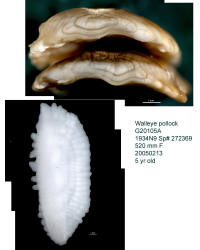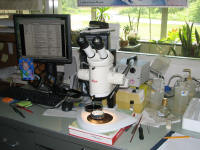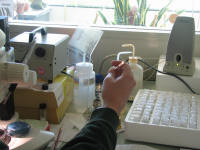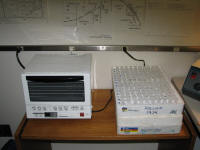 The
are many different parts to the processing of a large survey.
The
are many different parts to the processing of a large survey.  Scientists can tell the age of a fish by looking at some of the bones in the
fishes head. Bones that fish use for hearing, called otoliths, grow in rings
just like a tree. Count the rings to know the age of a fish. In this sequence
of photos, you can see how the scientists in the lab process one of the otolith.
They
Scientists can tell the age of a fish by looking at some of the bones in the
fishes head. Bones that fish use for hearing, called otoliths, grow in rings
just like a tree. Count the rings to know the age of a fish. In this sequence
of photos, you can see how the scientists in the lab process one of the otolith.
They
 count
the rings with a microscope. To make the samples clearer, scientists may choose
to burn a sample of bone or toast it. In the three photos to the right of your
screen, you can see one station where the scientists process the otoliths, a
scientist burning a sample and the equipment used to toast the bones. Want to
make them larger so you can see better? Just click on the photos.
Want to try your hand at telling the age of a fish?
Click here to
try an online simulation.
count
the rings with a microscope. To make the samples clearer, scientists may choose
to burn a sample of bone or toast it. In the three photos to the right of your
screen, you can see one station where the scientists process the otoliths, a
scientist burning a sample and the equipment used to toast the bones. Want to
make them larger so you can see better? Just click on the photos.
Want to try your hand at telling the age of a fish?
Click here to
try an online simulation.

In other parts of the lab, scientist look
at data from the echosounder on NOAA Ship MILLER FREEMAN, data from fishing
boats, and data from another research vessel that is also in the Bering Sea
doing trawls along the bottom. When it is call combined using computers here in
this lab, scientists will know about how many Walleye Pollock live in the Bering
Sea and can make a recommendation to the Fisheries Council so that the fisherman
can catch what we need to eat and still leave enough so that there are plenty of
fish for next year and the years to come.
 The
are many different parts to the processing of a large survey.
The
are many different parts to the processing of a large survey.  Scientists can tell the age of a fish by looking at some of the bones in the
fishes head. Bones that fish use for hearing, called otoliths, grow in rings
just like a tree. Count the rings to know the age of a fish. In this sequence
of photos, you can see how the scientists in the lab process one of the otolith.
They
Scientists can tell the age of a fish by looking at some of the bones in the
fishes head. Bones that fish use for hearing, called otoliths, grow in rings
just like a tree. Count the rings to know the age of a fish. In this sequence
of photos, you can see how the scientists in the lab process one of the otolith.
They
 count
the rings with a microscope. To make the samples clearer, scientists may choose
to burn a sample of bone or toast it. In the three photos to the right of your
screen, you can see one station where the scientists process the otoliths, a
scientist burning a sample and the equipment used to toast the bones. Want to
make them larger so you can see better? Just click on the photos.
Want to try your hand at telling the age of a fish?
Click here to
try an online simulation.
count
the rings with a microscope. To make the samples clearer, scientists may choose
to burn a sample of bone or toast it. In the three photos to the right of your
screen, you can see one station where the scientists process the otoliths, a
scientist burning a sample and the equipment used to toast the bones. Want to
make them larger so you can see better? Just click on the photos.
Want to try your hand at telling the age of a fish?
Click here to
try an online simulation.